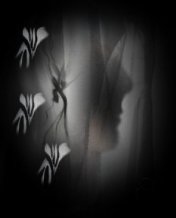 The heys of Bilhah, the handmaid of Rachel, represent powers of expression. The first hey represents the upper hey of the tetragrammton and the presence of the power to distinguish with mind, and to formulate understanding in the upper world of complex unity, paradoxically in the midst of chaos. The second hey represents the lower hey of the tetragrammton and the ability to translate that apprehended in the mind into an expression through malchut, in the lower world of plurality. This expression through malchut may be verbal, written, artistic or some other physical action bound up with the binah of Bilhah. Leah's name, having a single hey, the upper hey, cannot express that apprehended by the mind through malchut. Consequently, the binah of Leah remains bound up in the chaos and complexity of the world of Tohu, and is unable to be utilized in the world of Tikkun. From this, we can see that Bilhah contains the ability to rectify/utilize the great light of Tohu and to bring that great light of Tohu into the world of Tikkun and to utilize that great light for redemption.
The heys of Bilhah, the handmaid of Rachel, represent powers of expression. The first hey represents the upper hey of the tetragrammton and the presence of the power to distinguish with mind, and to formulate understanding in the upper world of complex unity, paradoxically in the midst of chaos. The second hey represents the lower hey of the tetragrammton and the ability to translate that apprehended in the mind into an expression through malchut, in the lower world of plurality. This expression through malchut may be verbal, written, artistic or some other physical action bound up with the binah of Bilhah. Leah's name, having a single hey, the upper hey, cannot express that apprehended by the mind through malchut. Consequently, the binah of Leah remains bound up in the chaos and complexity of the world of Tohu, and is unable to be utilized in the world of Tikkun. From this, we can see that Bilhah contains the ability to rectify/utilize the great light of Tohu and to bring that great light of Tohu into the world of Tikkun and to utilize that great light for redemption.
The ability to receive and produce an undistorted translation in the world of plurality from the world of unity (both complex and simple simultaneously), synthesizes the two worlds (like the akeidah did), creating a situation (as described in kabbalah) which raises one "above the wood" and brings down unity into plurality. This ability is related to the blessing following the Shema. This blessing is traditionally said in an undertone due to the danger of "raising other gods" in malchut (Adin Steinsaltz, In The Beginning) when bringing down light from the upper world into the lower world where evil is able to magnify disunity in malchut. Through Bilhah, rectification, elevation and unification of Yaakov's 4 wives (in the psyche of one woman really) is initiated. This is a secret of the shin of binah (the 4-headed shin).
This is why Yaakov (Bereshit 49) worried that his bed was incomplete on account of Reuven moving Yaakov's bed from Bilhah's tent into Leah's. The number 12 indicates disunity, a disunity arising in consequence to Reuven's action. Echad (1 and 13) indicates unity in plurality - and initiating this reality is the work of Bilhah. The gematria of Bilhah is 42, the same gematria as Yocheved, the mother of Moshe. Reuven's disruption caused Yocheved (a function of the feminine psyche) not to be realized immediately (through the transformation of Bilhah) and "moved redemption down in time", with Yocheved being born generations later as a descendent of Leah. Consequently, Reuven's action had a similar historical effect on redemption as did Bilaam's action in a later story of Torah (BeMidbar 24) - it removed redemption from the present time into the distant future.
Wednesday, December 28, 2005
Bilhah & Complex Unity
Posted by
Lori
at
9:03 PM
![]()
Labels: chaos and complexity, kabbalah
Subscribe to:
Post Comments (Atom)
Dare to be true to yourself.








No comments:
Post a Comment